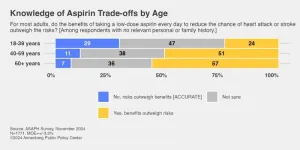(Press-News.org) Rice cultivation is responsible for around 12% of global methane emissions, and these emissions are expected to increase with global warming and as the human population continues to grow. Now, scientists have identified chemical compounds released by rice roots that determine how much methane the plants emit. On February 3 in the Cell Press journal Molecular Plant, they report that this information enabled them to breed a new strain of rice that emits up to 70% less methane.
“This study shows that you can have low methane and still have a rice with high yields,” says senior author Anna Schnürer, a microbiologist at the Swedish University of Agricultural Sciences. “And you can do it using traditional breeding methods, without GMO, if you know what you’re looking for.”
The methane emitted by rice paddies is produced by microbes that break down organic compounds released from rice plant roots. Rice and other plants release these compounds, known as “root exudates,” to feed soil microbes, which in turn aid plant growth by releasing nutrients that the plants can absorb. Though it’s been long understood that soil microbes and root exudates are involved in methane emissions, it was unclear which chemical compounds in root exudates were responsible.
To identify which root exudate compounds are converted into methane, the researchers compared root exudates from two different rice varieties —SUSIBA2, a low-methane emitting GMO variety, and Nipponbare, a non-GMO cultivar with average methane emissions. They found that SUSIBA2 roots produced significantly less fumarate and noted a correlation between the amount of fumarate secreted and the abundance of methane-releasing archaea or “methanogens” in the surrounding soil.
To confirm fumarate’s role, the researchers added fumarate to the soil of rice plants grown in containers, which resulted in increased methane emissions. They also demonstrated that applying oxantel, a chemical that inhibits the enzymatic breakdown of fumarate, effectively reduced methane emissions. However, since the SUSIBA2 plants still produced less methane than the Nipponbare plants, the researchers realized that fumarate isn’t the only piece to the puzzle.
“It was almost like having a riddle,” says Schnürer. “We noticed that the soil itself contained something that reduced methane emissions, so we started thinking that there must be an inhibitor of some kind that is also causing the difference between the varieties.”
When they re-analyzed the root exudates, the team noticed that SUSIBA2 plants also release significantly more ethanol. Adding ethanol to the soil surrounding rice plants reduced methane emissions.
Next, the team investigated whether they could use traditional breeding methods to produce low methane-emitting rice with high yield. To do this, they crossbred a high yield or “elite” rice variety with a previously identified low-methane-emitting variety (the Heijing cultivar) whose root exudate was low in fumarate and high in ethanol.
The rice plants from this crossbreeding consistently released root exudates with low fumarate and high ethanol (LFHE) profiles. When the researchers grew these LFHE rice varieties at various field sites throughout China, they showed that the LFHE rice produced 70% less methane on average compared with the elite variety from which it was bred. The LFHE crops also produced relatively high yields—8.96 tons/hectare on average, compared to the 2024 global average of 4.71 tons/hectare.
The researchers also investigated whether ethanol and oxantel could be used to reduce methane emissions at a large scale. Based on a two-year field trial at two different sites in China, this treatment resulted in approximately 60% reduction in methane emissions without impacting crop yield.
Now, the researchers are working to register the LFHE rice as a variety with the Chinese government and others, meaning that it could be marketed to farmers in the future. They’re also working with fertilizer companies to investigate whether oxantel could be added to commercial fertilizers.
“To make these things happen, we’ll also need some encouragement from governments to motivate and support farmers to use these low-methane varieties,” says Schnürer. “It’s one thing to breed eco-friendly rice varieties, but then it’s critical to get them on the market and to get the farmers to accept them.”
###
This research was supported by Mr. Zheng Fang, Beijing Xianhe Transportation Technology Co. Ltd., Trees and Crops for the Future, the Swedish Research Council for Environment, Agricultural Sciences and Spatial Planning, NSFC Projects of International Cooperation and Exchanges, and the China Scholarship Council.
Molecular Plant, Jin et al., “Reducing methane emissions by developing low-fumarate high-ethanol eco-friendly rice.” https://www.cell.com/molecular-plant/fulltext/S1674-2052(25)00029-2
Molecular Plant (@MPlantPCom), published by Cell Press for the Center for Excellence in Molecular Plant Sciences (Shanghai), Chinese Academy of Sciences, and Chinese Society of Plant Biology, is a monthly journal that focuses broadly on plant science, including cellular biology, physiology, biochemistry, molecular biology, genetics, development, plant-microbe interaction, genomics, bioinformatics, and molecular evolution. All contents are freely available starting 12 months after publication. Visit http://www.cell.com/molecular-plant. To receive Cell Press media alerts, contact press@cell.com.
END
About The Study: In 2023, post–COVID condition (PCC) continued to affect U.S. children at similar levels as 2022 and to have similar sociodemographic patterns. The large proportion of children experiencing PCC with any activity limitation highlights the need to examine the severity of activity limitation, functional outcomes, and days lost from school.
Corresponding Author: To contact the corresponding author, Nicole D. Ford, PhD, MPH, email yex9@cdc.gov.
To access the embargoed study: Visit our For The Media website ...
About The Study: This cohort study of hospitalized adults identified inequities related to race and rurality in health care–associated infections (HAIs) and adverse outcomes from HAIs. These findings suggest that factors such as structural racism and disinvestment in rural communities may be associated with individual HAI risk and post-HAI outcomes. Future work to further understand the reasons underpinning these disparities and methods to address structural factors through policy and process changes are critical to ...
About The Study: The results of this cohort study revealing the robust and persistent association of headache diagnoses with attempted and completed suicide suggest that behavioral health evaluation and treatment may be important for these patients.
Corresponding Author: To contact the corresponding author, Holly Elser, MD, PhD, email holly.elser@pennmedicine.upenn.edu.
To access the embargoed study: Visit our For The Media website at this link https://media.jamanetwork.com/
(doi:10.1001/jamaneurol.2024.4974)
Editor’s Note: Please see the article for ...
About The Study: Using passive sensing on a sample of U.S. adolescents, this study found half of adolescents use their smartphones during school for at least 66 minutes daily, primarily using messaging and social media. These findings extend a prior study limited to Android devices that found adolescents spent a median of 43 minutes on their phones during school.
Corresponding Author: To contact the corresponding author, Lauren Hale, PhD, email Lauren.Hale@stonybrookmedicine.edu.
To ...
Alarming Rise in Rates of Advanced Prostate Cancer in California
Following a change in screening guidelines, the incidence went up across the state, even more than it has nationally.
The incidence of advanced prostate cancer in California rose markedly in the decade since doctors stopped routinely screening all men for the disease, according to a new study by UC San Francisco.
After declining for many years, the death rate from the disease also plateaued in most regions across the state.
The findings reinforce the need for screening that can identify potentially fatal tumors without raising false alarms about ones that pose no threat to the patient.
The ...
For years, healthy older adults were advised by doctors to take a low-dose aspirin daily as a way to reduce the risk of heart attack. But in March 2019, the American College of Cardiology and the American Heart Association (AHA) announced new guidelines and no longer routinely recommended a daily dose of aspirin for healthy adults over the age of 70 because the risk of gastrointestinal bleeding outweighs the benefits.
Nearly five years later, many Americans still have not received the message.
The Annenberg Public Policy Center (APPC) of the University of Pennsylvania finds in a new health survey that nearly half (48%) of U.S. ...
Secondary prevention medications for cardiovascular diseases (CVD) are underused globally and additional strategies to increase their use are needed to improve CVD management and reduce premature mortality rates, according to study published today in JACC, the flagship journal of the American College of Cardiology. The study observed participants with CVD from 17 countries over 12 years and found that medication use remains low with little improvement.
Secondary prevention of CVD focuses on preventing further health problems in people already diagnosed with CVD. This includes managing risk factors through lifestyle changes, medications and ...
Approximately half of all Americans do not take their medication as prescribed by their doctor. This medication non-adherence causes an estimated 125,000 additional deaths and as much as $300 billion a year in additional medical appointments, emergency department visits, and hospitalizations.
A new study published in the Journal of the American Medical Association (JAMA) Network Open finds Amazon Pharmacy’s subscription service for common medications, RxPass, leads to significant improvements in medication adherence while reducing out-of-pocket costs for patients. This first-of-its-kind study evaluated the potential of subscription models to support prescription medication access ...
With demand for physical therapy services projected to increase 27 percent by 2030, Tufts University School of Medicine (TUSM) and ATI Physical Therapy (ATI), a leading provider of physical therapy services across the United States, are launching a joint initiative aimed at expanding the physical therapist workforce and making the Doctor of Physical Therapy (DPT) Programs at TUSM more accessible.
As part of the first-of-its-kind collaboration, TUSM and ATI will contribute scholarships each semester for up to 45 ATI employees in TUSM’s DPT programs each academic year. The accelerated ...
Emerging evidence suggests that lycopene—a natural plant extract—may have antidepressant properties. New research in Food Science & Nutrition reveals the mechanisms behind its antidepressant effects.
In mice with depressive-like behaviors, brain analyses revealed impairments in the hippocampus. Lycopene treatment lessened these impairments and reversed the animals’ depressive-like traits.
Lycopene treatment boosted the expression of brain-derived neurotrophic factor (BDNF), a protein with roles in many aspects of brain function. Experiments indicated that a signaling pathway involving BDNF (called the BDNF-TrkB pathway, ...



